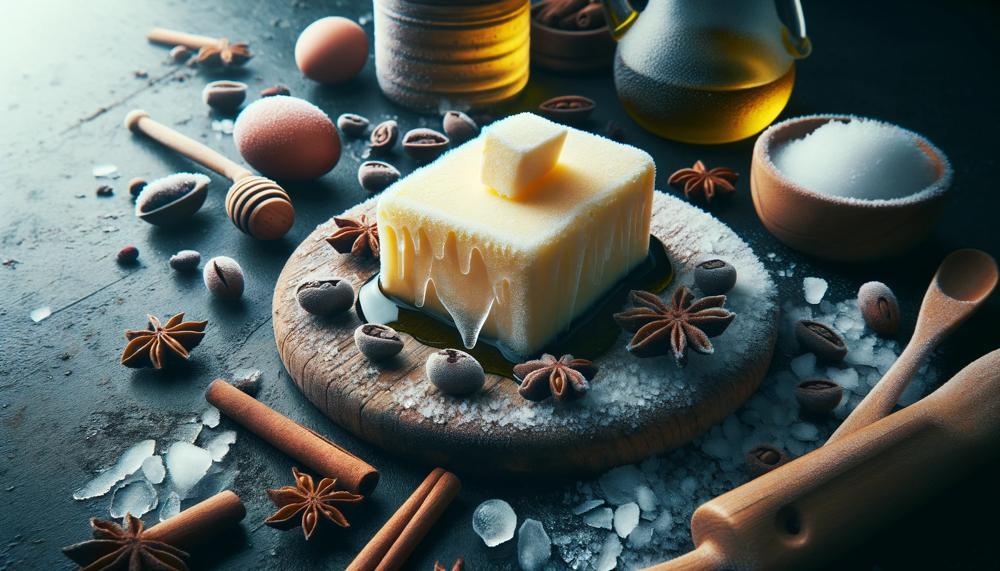Freezing butter can be a convenient way to extend its shelf life and ensure you never run out when you need it. Whether you prefer salted or unsalted butter, both types freeze well and can be stored in their original packaging or transferred to a resealable freezer storage bag.
Frozen butter can be safely stored for up to four months if frozen before the use-by date on the package. However, it’s important to note that after this time, it may start to lose its fresh taste and absorb flavors and odors from the freezer. Thawing frozen butter before use is recommended, although there are techniques and recipes that allow for the use of frozen butter.
Contents
Key Takeaways:
- Frozen butter can be stored for up to four months without compromising its quality, flavor, and texture.
- Thawing frozen butter is recommended before use, but there are techniques and recipes that allow for the use of frozen butter.
- Frozen butter is particularly useful in recipes that require cold butter to create steam and achieve a flaky texture, such as biscuits and pie crusts.
- Proper packaging, such as parchment paper, foil, or cling wrap, is essential for maintaining the quality of frozen butter.
- Thawing techniques, such as refrigerator thawing or grating for faster thawing, ensure the safe and convenient use of frozen butter.
How Long Will Frozen Butter Keep?
Proper freezer storage extends the shelf life of frozen butter to up to six months. But after then, the butter’s quality can start to decline.
Freezing Butter: Tips and Guidelines
When it comes to freezing butter, it’s important to follow the right guidelines to ensure that it maintains its quality and texture. Whether you have stick butter or bulk blocks, proper packaging and thawing techniques are key to preserving the butter’s freshness and flavor.
Butter with a fat content of at least 80% is ideal for freezing. The high fat content helps to maintain the butter’s structure and prevents it from becoming too watery or separated when thawed. Stick butter can be safely frozen for up to 12 months at 0°F (-18°C), while bulk blocks of butter can last even longer, up to 18 months.
Pro Tip: To make sure you’re freezing the butter while it’s at its best, freeze it soon after purchasing or when it’s still fresh. This will help ensure that it retains its flavor and quality throughout the freezing process.
When it comes to packaging the butter for freezing, it’s important to choose the right materials. Avoid using wax paper, as it can actually decrease the quality and flavor of the butter. Instead, opt for freezer-safe options such as parchment paper, foil, cling wrap, or even the original packaging. These materials provide a protective barrier against freezer burn and help maintain the butter’s taste and texture.
Thawing frozen butter can be done in different ways depending on your preference and time constraints. For a gradual thaw, place the frozen butter in the refrigerator overnight. This allows it to thaw slowly while maintaining its structure. If you need to use the butter more quickly, thawing at room temperature for a few hours is also an option.
Pro Tip: If you’re in a hurry and need to thaw the butter immediately, there are techniques that can help speed up the process. One technique is grating the frozen butter, which allows it to thaw much faster due to the increased surface area. Another technique is melting the frozen butter directly from its frozen state on the stovetop or in the microwave, but be careful to avoid overheating or burning the butter.
Using Frozen Butter in Recipes
Frozen butter is a versatile ingredient that can elevate the texture and flavor of various recipes, especially those involving baking and pastry dough. Incorporating frozen butter into your cooking repertoire opens up a world of possibilities, allowing you to create delicious treats with ease and convenience.
When it comes to recipes that require cold butter to achieve a flaky texture, such as biscuits and pie crusts, using frozen butter is highly recommended. One technique to incorporate frozen butter into these recipes is by grating it over flour and tossing them together. This ensures that the butter remains cold, allowing it to create steam pockets during the baking process, resulting in a delightful flakiness.
Not only is grated frozen butter perfect for biscuits and pie crusts, but it can also be used in various other pastries that demand a light and delicate texture. Think of delicious scones, croissants, or even puff pastry. The icy coldness of the grated butter provides a perfect base for creating layers, making your pastries turn out beautifully.
Although many recipes call for softened or melted butter, some may specifically require melted butter. You can easily achieve this by heating frozen butter on the stovetop or in the microwave. Just be sure to use the melted butter for recipes that explicitly call for it and not for baking purposes or recipes that require softened butter.
Frozen Butter Recipe Recommendations
- Flaky Buttermilk Biscuits with Frozen Butter
- Classic Apple Pie with Frozen Butter Crust
- Butter Croissants using Grated Frozen Butter
- Savory Quiche with Frozen Butter Crust
Incorporating frozen butter into your recipes not only adds convenience but also enhances the final product’s texture and taste. So, the next time you’re preparing a recipe that calls for cold butter, reach for that frozen block to achieve delectable and flaky results.
| Recipe | Recommended Frozen Butter Technique |
|---|---|
| Flaky Buttermilk Biscuits | Grate frozen butter over flour, then toss together |
| Classic Apple Pie | Use grated frozen butter in the pie crust |
| Butter Croissants | Incorporate grated frozen butter into the dough layers |
| Savory Quiche | Use a frozen butter crust for a flaky base |
Frozen Butter Storage and Packaging Tips

When it comes to freezing butter, proper storage and packaging are key to maintaining its quality and flavor. Here are some essential tips to help you freeze your fresh butter effectively:
Freeze Fresh Butter
To ensure the best results, it is recommended to freeze butter when it is fresh rather than close to its expiration date. Freezing butter close to its use-by date may affect its texture and flavor.
Cut into Smaller Portions
If you anticipate using small amounts of butter at a time, consider cutting it into smaller portions before freezing. This will simplify the thawing process, allowing you to defrost only the amount you need for a particular recipe.
Select the Right Packaging Options
Choosing the appropriate packaging is vital to keep your frozen butter in optimal condition. Here are some packaging options to consider:
- Parchment paper: Wrap individual butter portions in parchment paper before placing them in a sealed container or resealable freezer storage bag.
- Foil: Similar to parchment paper, wrapping butter portions in foil provides an extra layer of protection against freezer burn.
- Cling wrap: If using cling wrap, ensure it is designed for freezer use. Wrap the butter tightly to prevent air from reaching it.
- Original packaging: If the butter is in a sturdy, freezer-safe container, such as a foil-wrapped stick or a plastic tub with a secure lid, you can freeze it directly in its original packaging. However, consider placing the original packaging in a resealable freezer storage bag for added protection.
It is important to avoid using wax paper for freezing butter, as it may compromise its quality and flavor.
Separate from Odorous Foods
To prevent your frozen butter from absorbing unwanted flavors and odors, keep it away from strong-smelling foods in the freezer. Ideally, store it in a separate compartment or place it in an airtight container to minimize cross-contamination.
By following these freezing guidelines and packaging tips, you can ensure that your fresh butter stays delicious and ready to use whenever you need it.
Thawing Frozen Butter: Techniques and Tips
Thawing frozen butter is a crucial step in using it for cooking and baking. There are several techniques and tips you can follow to ensure that your frozen butter thaws safely and efficiently. Whether you prefer using the refrigerator, countertop, grating, or melting methods, it’s essential to take safety precautions to avoid any mishaps.
Thawing in the Refrigerator
Thawing frozen butter in the refrigerator is the most recommended method as it allows for controlled and gradual thawing. Simply remove the frozen butter from the freezer and place it in the refrigerator overnight. This slow thawing process ensures that the butter retains its texture and quality.
Thawing on the Countertop
If you need to thaw your frozen butter more quickly, you can use the countertop method. Take the desired amount of frozen butter and place it on a plate or in a shallow dish. Allow the butter to thaw at room temperature for a few hours until it reaches a soft consistency. Remember to keep the butter covered to protect it from any contaminants.
Grating Frozen Butter
Grating frozen butter is an excellent technique for accelerating the thawing process. Simply take a frozen stick of butter and grate it using a box grater or a food processor with a grating attachment. The grated butter thaws within minutes and can be easily incorporated into your recipes.
Melting Frozen Butter
In some recipes, melted butter is required. You can melt frozen butter directly from its frozen state using either the stovetop or the microwave. However, it’s essential to be cautious as the butter can quickly become soupy or even explode in the microwave. Melt the frozen butter slowly over low heat on the stovetop or in short bursts in the microwave, stirring frequently until it reaches the desired consistency.
When thawing frozen butter, always remember to check for signs of freezer burn, off colors, or a bad smell. If any of these are present, it’s best to discard the butter.
| Thawing Method | Pros | Cons |
|---|---|---|
| Refrigerator | – Controlled and gradual thawing – Retains texture and quality | – Longer thawing time |
| Countertop | – Faster thawing | – Risk of exposure to contaminants – Potential for uneven thawing |
| Grating | – Quick thawing | – Requires additional tools |
| Melting | – Rapid thawing for recipes requiring melted butter | – Risk of overheating or explosion in microwave |
Keep in mind that the method you choose may depend on the specific recipe and time constraints. By following these techniques and safety precautions, you can ensure that your thawed butter is ready to be used in your favorite dishes.
Also Read: Does Pillsbury Dough Expire?
Conclusion
Freezing butter offers a convenient solution for maintaining a steady supply of this versatile ingredient for all your baking and cooking needs. By following the recommended freezing guidelines and using appropriate packaging options, frozen butter can retain its quality and flavors for an extended period. Thawing techniques provide a quick and safe way to incorporate frozen butter into your recipes, enhancing convenience and versatility in your culinary endeavors.
Whether you require cold butter for achieving flaky pastries or melted butter for various recipes, freezing butter proves to be a practical and time-saving solution. Its extended shelf life ensures that you will never run out at crucial moments, allowing you to effortlessly create delicious dishes without making last-minute trips to the store. Plus, when properly stored and thawed, frozen butter maintains its taste and consistency, guaranteeing optimal results in your favorite recipes.
With frozen butter readily available in your freezer, you can easily whip up a batch of buttery biscuits, create a perfect pie crust, or add richness to your sauces and spreads. The convenience provided by frozen butter empowers novice home cooks and seasoned bakers alike to experiment with a range of culinary creations. Expand your repertoire of delectable dishes, embrace the benefits of freezing butter, and elevate your cooking experiences in the kitchen.
Source Links
- https://www.landolakes.com/expert-advice/can-you-freeze-butter/
- https://www.realsimple.com/can-you-freeze-butter-7571113
- https://www.healthline.com/nutrition/can-you-freeze-butter




